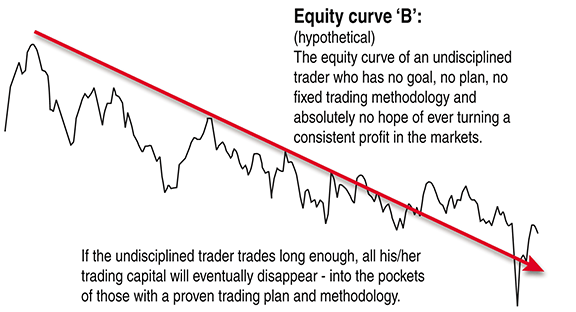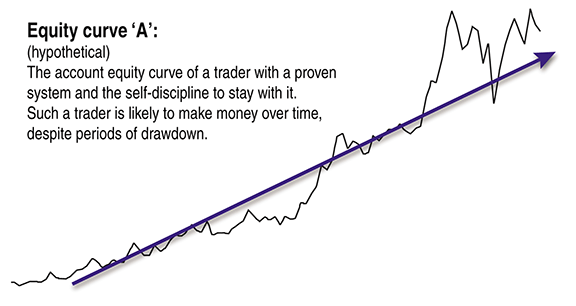
HOT TOPICS LIST
- Strategies
- Stocks
- Buy
- Investing
- Brokers
- Psychology
- Interviews
- Accumulate
- Sell
- Hold
- Spotlight
- Websites
- Candlestick Corner
- Gold & Metals
- Options Trading
LIST OF TOPICS
TRADER'S NOTEBOOK
Crash Course For Novice Traders
08/19/09 11:31:46 AM PSTby Donald Pendergast
If you do the time, you'll get the prize.
| So you've been learning all you can about trading for the past few months. You've read books authored by top trading and investing pros. You've managed to make it through several trading-related infomercials, you watch CNBC all day long (when the boss isn't looking over your shoulder, of course), and you've even subscribed to The Wall Street Journal. It generally appears to you that making money in the financial markets is a relatively painless, straightforward, "follow the system and you can't lose" kind of personal endeavor. Yet despite all of the market information, sales pitches, and education that you've been inundated with, you can't seem to figure out how to get started in this business called trading and investing. So you do nothing, waiting for either the perfect trade to materialize or, more likely, for your confidence level to get high enough to seek out a reputable trainer, mentor, or advisor who's been there, done that, and managed to survive in order to trade again. If this even partially describes your current relationship with the financial markets, let me assure you that waiting is the safest course of action you could have possibly taken -- until now. The reason why waiting is so vital for fledgling traders (especially when they first experience the initial wave of euphoria that ensues once they get enamored with the idea of making big money in the markets) is because they haven't begun to determine what they wish to accomplish by trading. How much money can they use to trade? How much of that money can they afford to lose (and they'll probably lose a lot more than they think, especially during the first year or two or three)? How much time can they devote to it? What kind of methodology or system can they use, what education will they need, what broker and/or trading platform will they use, what charting software will they utilize, what kind of computer hardware and Internet connection will be required... the list goes on. Even if they rely on trading systems and/or newsletters and advisory services put out by others, they still need to have a good understanding of how the markets work on both a technical and fundamental basis. Novice traders also need to know how to enter their trades into their trading platform on a consistently error-free basis. Essentially, there are many things to consider before simply plunking your cash down in a brokerage account, studying a few charts, and then firing off winning trade after winning trade. Take this crash course for new traders now, lest you end up trashing your trading account beyond all recognition. |
| BASIC CHECKLIST Personal trading goals and risk assessment:
Mode of trading:
Methodology/system:
Computer/communications and hardware:
ONLY YOU |
| Right now, though, let's speed up your learning process to get you to focus on one style of trading, something that you'll be able to stay with and hopefully build upon as your level of skill and experience continues to grow. FOCUS Ironically, I still had my share of great winning trades along the way, most of which were based on momentum setups in extremely hot markets (think silver in 1979, mutual funds in 1986-87, and Internet stocks from 1997 to 2000). For me, epiphany came late. I realized that I was an outstanding fundamentally based trader, and when I focused on investing/trading things like silver, crude oil, and commodity-linked equities, the trading profits were more frequent than when I tried to trade from a technical-only framework. Later on, I developed a winning mechanical trading system for stocks that also used various technical and fundamental filters to mine for the stocks most likely to follow through. Regardless of what I traded, I found that having a solid understanding of the fundamentals always gave me a much better edge than if I tried to rely on technical indicators, chart patterns, or mechanical trade signals alone. Of course, that's just my story; yours is likely to be different. The main idea is this: Learn from your trading experiences. Over time, you'll finally learn what your exact style is and how to best profit from it. You'll never win on every trade, but if you determine where your particular strengths are and maximize them (at the same time discerning what your weaknesses are and minimizing them), you're sure to be performing at your best as you interact with the stock and commodity markets. |
| Right now, however, take the time to consider each of the questions previously mentioned, and when you've done that, take a good, hard look at the two hypothetical equity curves I show here. The choice is yours to make: you can trade like an undisciplined, unstable, double-minded, insecure, anxious, and fearful trader and end up with a trading account equity curve that looks like the ski slopes of Taos, NM (equity curve B) such as the one in Figure 1. Or you can ask yourself the hard questions and begin the long, taxing process of becoming a disciplined trader with a proven trading plan and a winning trading methodology.
FIGURE 1: EQUITY CURVE OF AN UNDISCIPLINED TRADER |
| If you're willing to put in the time, stay focused on your strengths, diligently pursue your trading plan and consistently execute the trades from your proven trading method or system, chances are you'll have an account equity curve that, over time, hopefully begins to resemble that of equity curve A in Figure 2.
FIGURE 2: EQUITY CURVE OF A DISCIPLINED TRADER |
Donald Pendergast has studied technical price charts and market dynamics for more than 30 years and has had more than 1,000 articles on technical analysis, trading system development, and high-probability chart setups published at several trading/investing publications since 2008. Pendergast offers real-world trading signals for a basket of eight gold/silver mining stocks/ETFs and also offers high-quality, customized analysis for US stocks. He may be reached at 904 303-4814, at lineartradingsys@gmail.com, or via his website at https://sites.google.com/site/goldandsilverstockssignals/.
| Website: | sites.google.com/site/goldandsilverstockssignals/ |
| E-mail address: | lineartradingsys@gmail.com |
PRINT THIS ARTICLE

|

Request Information From Our Sponsors
- StockCharts.com, Inc.
- Candle Patterns
- Candlestick Charting Explained
- Intermarket Technical Analysis
- John Murphy on Chart Analysis
- John Murphy's Chart Pattern Recognition
- John Murphy's Market Message
- MurphyExplainsMarketAnalysis-Intermarket Analysis
- MurphyExplainsMarketAnalysis-Visual Analysis
- StockCharts.com
- Technical Analysis of the Financial Markets
- The Visual Investor
- VectorVest, Inc.
- Executive Premier Workshop
- One-Day Options Course
- OptionsPro
- Retirement Income Workshop
- Sure-Fire Trading Systems (VectorVest, Inc.)
- Trading as a Business Workshop
- VectorVest 7 EOD
- VectorVest 7 RealTime/IntraDay
- VectorVest AutoTester
- VectorVest Educational Services
- VectorVest OnLine
- VectorVest Options Analyzer
- VectorVest ProGraphics v6.0
- VectorVest ProTrader 7
- VectorVest RealTime Derby Tool
- VectorVest Simulator
- VectorVest Variator
- VectorVest Watchdog


